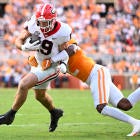If you're reading this, you're either already in an auction or want to be in one.
If you're already in an auction, you know how awesome they are.
If you're not in an auction but want to be, make it happen.
Auctions are more fun and competitive than standard snake drafts. They offer way more flexibility in putting a roster together. You don't have to wait your turn to get players and you can walk into an auction with the name of one player you desperately want and guarantee he will be on your team.
Sure, you might have to think a little more, but you'll think about Fantasy Football, not filing your taxes. And it might take a little longer than a snake draft, but if you're with people you like then that's not a bad thing.
You can even do auctions online -- even on this website!
We can't help it if the people you do Fantasy leagues with are dweebs who are deep-rooted in snake-draft tradition. All we can do is offer up a way to change the years-old way your league has been playing. If they're not open to it, maybe it's time to start up another league.
Why tiers matter
If you went to buy a car and had a list of the last five prices the car you wanted sold for, you'd have a pretty good idea of what you'd expect to pay.
The same principle applies when it comes to bidding on players you pre-sort into tiers. Once you see what a couple of guys at a similar Fantasy value go for at auction, you can reasonably expect to pay in the same range for the next player in that tier.
An example:
Antonio Brown goes off the board for $35.
Odell Beckham sells for $34.
Someone wins Julio Jones for $33.
Now you have a ballpark figure for what you want to pay for DeAndre Hopkins, Dez Bryant and every other quality No. 1 Fantasy receiver.
So take the time to borrow our rankings. Go ahead and re-do the order to however you like the players at each position. Then start grouping them based on how many yards and touchdowns you think they'll get.
From there, pay attention in your auction. Once a tier is down to the last player or two, jump in and start bidding. You'll know what to pay for them and you'll be comfortable adding them to your team since you already pre-placed them into a specific group.
This gameplan works with any position at any level, from 1,000-yard studs to in-case-of-emergency backups. You don't have to be this organized to pull together a strong roster following an auction, but you'll drastically improve your chances if you plan in advance.
Why money matters
As you probably already know, auctions involve spending dollars. In most cases, these dollars are fake and can only be spent on real players for your fake Fantasy team. You can't save your fake dollars and spend them on a video game later.
So spend them.
You'll obviously have players you want for sure. Go get them. If it means spending the extra dollar, go for it. Or maybe you'll get lucky and win them for less than expected. Either way, it's never bad to put one or two players on your must-get list, and then go get them.
But like anything involving money, there will be bargains. Once the rush of winning bids on quality players wears off (after the first 20 or 30 nominations) you should expect to find some good values. The best position to expect this is quarterback, where most owners will be shy coughing up anything more than a few bucks on any passer not ranked in the Top 5. Ditto that for tight ends not named Gronkowski, Reed, Eifert or Olsen. These are two areas where owners should expect to land deals on players that won't set them back.
Does this mean people shouldn't spend money early on? It's a strategy some people use, but who's to say there aren't good deals among the players nominated from the jump? If you're paying attention and you see a player in the bidding process at a price that's fair to you, then bid.
Here's what you shouldn't do:
- Don't drive up prices on players you don't need. You'll get burned.
- Don't blow up your budget early
- But don't save all your money, either
- When it comes to nominating players, don't bring up players you want early on. In fact, nominate the players you don't want who will fetch a large price tag. Then flip the script after 40 or so players have been auctioned and nominate players you do want.
If you have roughly 25 percent of your overall budget for the last third of the auction then you're a cinch to get at least two steals.
Why paying attention matters
If you keep tabs on how all of the other owners are spending their money, you'll find some hidden information that should help.
For one thing, you'll know how much they've all spent and can compare it to your wallet. You could tailor your nominations to their needs -- if the guy with the most money left needs a running back and no one's nominated Jay Ajayi, go ahead and drop his name so that Mr. Moneybags spews funds.
Say one of them needs a quarterback, and you do too. What if their max bid was $5 and yours was more? You could put yourself in a position to either get the quarterback they can't afford or watch them blow their remaining dollars, then get another player at potentially a lower price.
It's also worth paying attention to everyone's cash situation when it comes to nominating players at the end of the auction. If there's a bench player you'll pay $2 or $3 for, nominate him for that much so others who can't bid $4 won't get him.
Staying focused on the draft will also keep the process from being a source of boredom. This is Fantasy Football -- not a chore. Stick with it and the time will fly by as you build a championship-winning squad.























